
What is cardiac catheterization and angiography, why are these procedures needed?
Cardiac catheterization and angiography are diagnostic methods, not treatment. It is based on imaging the heart cavities and coronary arteries during the administration of contrast material (a kind of medical dye) and taking motion pictures using “X” rays. The data obtained are very valuable in guiding treatment and are the main determinant for the choice of treatment strategy in most patients. Thanks to today’s technological conditions and knowledge, the success rate of the mentioned procedures is over 99%.
How is cardiac catheterization and angiography performed?
Fasting for 4-12 hours is required before cardiac catheterization and angiography (drugs can be taken with a very small amount of water). Before the patient is taken to the catheter laboratory, the inguinal area should be shaved to ensure better sterilization. A sedative is administered when necessary. The groin or arm area where the procedure will be performed is anesthetized and a cannula is inserted into the artery in this area (the access route is opened). The pressure is recorded by reaching the heart cavities with a thin tube (catheter) made of plastic-like material; Coronary arteries are visualized by giving contrast material and film recordings are taken.
This process takes about 20-30 minutes. After the procedure is completed, the cannula in the groin is removed and pressure is applied to this area for 15-20 minutes. After it is seen that the bleeding has stopped, it is closed with a very tight bandage. However, in some cases of medical necessity, this practice can be changed since the cannula in the groin may need to be kept in place for a longer period of time. Except for exceptional cases, the patient is allowed to return to his daily life 24 hours after the procedure.
Could there be undesirable events associated with cardiac catheterization and angiography, what is the risk of the procedure?
Although rare, procedural problems and adverse events (complications) may be encountered during or immediately after cardiac catheterization. After the coronary angiography procedure, pain, mild swelling and bruising (hematoma, ecchymosis, pseudo-aneurysm) may occur in the vascular area, which is less frequently treated. However, the probability of complications requiring repair in the operation area is 2%. Rarely, there is a possibility of stroke (stroke) and myocardial infarction. The incidence of these events in experienced catheter laboratories is around 2 in 1000. It is known that the vital risk is less than 2 in 1000. Other than these, some complications (emergency surgery, perforation of the heart vessels and cavities, low blood pressure due to severe allergic reaction, some rhythm disorders, need for a temporary pacemaker, etc.) can be seen, albeit very rarely. Reactions with temporary low blood pressure called “vagal reaction” and cold sweating may develop due to the pain felt due to the withdrawal of the cannula from the groin during or after the insertion of the cannula in the inguinal region (2%). Most of these complications can be compensated with treatment. Depending on the drugs used during the procedure, especially the iodinated contrast material, kidney failure may develop. Although the majority of patients with renal failure improve, they may rarely require dialysis treatment later in life.
What kind of problems can be encountered if cardiac catheterization and angiography are required but not performed?
If cardiac catheterization and angiography are not performed, adequate information about the patient’s disease cannot be obtained, and the necessary interventions and treatments may not be planned in a healthy way.
Are there alternative examination methods that can replace cardiac catheterization and angiography?
In parallel with the developments in technology, although there are great developments in cardiac imaging methods, non-invasive (bloodless) diagnostic methods (examinations with computerized tomography or magnetic resonance methods) that can completely replace cardiac catheterization and angiography and can provide as precise information as these methods. etc.) are not available.
Can or should balloon angioplasty and heart surgery be performed immediately, which is decided according to the results of cardiac catheterization and angiography?
It should be known that there may be a need for coronary therapeutic intervention (coronary balloon angioplasty, coronary stent applications, etc.) or emergency cardiac surgery in the same session, due to a complication of the catheterization and angiography procedure or in the event that the need for urgent intervention is determined for the main disease that caused the patient to be examined. Except for the emergencies mentioned above, a decision is made about the further examination or treatment method by evaluating the angiography, and the necessary interventions and treatments are planned by informing the patient about this issue. However, if the patient gives consent and the physician deems it appropriate, coronary therapeutic intervention can also be performed in the same session.





